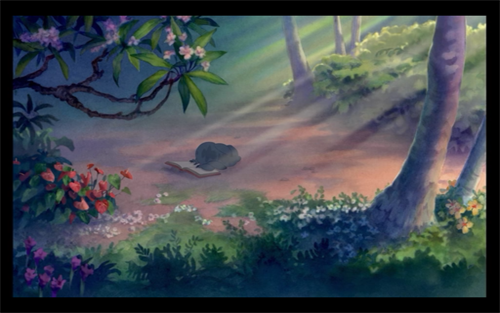
Image credit: captured from Netflix.com
If Frozen (as my previous blog argues) gleefully revises Disney’s traditional iconography, Lilo and Stitch does something far more interesting. Both are, in their ways, re-telling of fairy tales, but Lilo and Stitch proves far weirder, as well as far more intelligent, than its visually-immaculate descendent. We have already discussed Lilo and Stitch once at the Viz blog, praising it for its ability to subvert the “prince charming” narrative. Yet Lilo and Stitch is certainly worth at least one more look. The film is, in fact, both far more critical, and far more thoughtful, than Frozen is. Indeed, the film (despite its rough spots) is sophisticated and thoughtful in a lot of ways that Frozen never dreams of being, and may have something quite important to say about the way we engage with popular children’s stories.
The scene at the heart of the film—and I am aware this may be a contentious statement—involves neither of the female leads, but rather Stitch, Lilo’s hyperactive, destructive, pet alien “dog.” Near the climax of the film, when Stitch is finally coming to be accepted by his nontraditional adoptive family, he uncharacteristically runs away. Taking Lilo’s beautiful picture-book of The Ugly Duckling, he vanishes into the woods; there, in the rain (of course), he expresses a sorrow previously alien to his nature. “I’m lost,” he cries, before the scene fades to black.
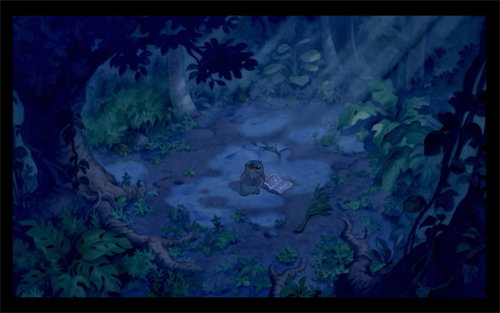
Image credit: captured from Netflix.com
The scene would be puzzling, and seems to break with the film’s otherwise-reasonable plotting. Stitch has a lot of deficiencies, to put it mildly, but a lack of directional sense is not one of them. Nor is he particularly prone to deploy creative metaphors, or to express heartfelt narratives of any sort. Helpfully, however, the film gives us a key image to let us understand Stitch’s plight. Moments before, the camera showed us the page Stitch was reading; an image of the Ugly Duckling, alone, wishing for his family to be reunited with him. Stitch, in fact, emulates the Ugly Duckling’s pose as he mimics the story’s dialog, while the virtual camera floats to the proper height to cement the visual similarity.
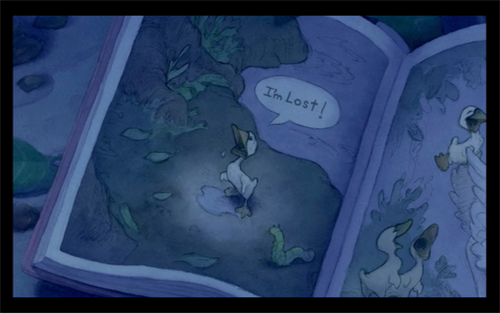
Image credit: captured from Netflix.com
The moment has a cruel brilliance to it. Stitch misses the point of the narrative even as he re-enacts its climactic scene. Already, he had found his kind—Lilo loved him unconditionally from the first, and even her older sister Nani was forced to accept that he counts as ohana, part of a family where “nobody gets left behind and forgotten.” In any other Disney movie, Stitch would have come to a saccharine realization that the story of “The Ugly Duckling” is about his relationship with Lilo and Nani, and would have come to a happy ending then and there. Instead, he is unable to see the two orphaned sisters, who yell at each other and inhabit a house full of unmade dishes and filth-covered stoves, as part of the same world as an elegant swan and her children. So he waits, in the woods, repeating the phrase “I’m lost” while hoping that such mimicry will automatically generate the happy ending that the fairy-tale promised. A fairy tale that many people see as beautiful and true becomes, for Stitch, an elegant lie that keeps him from embracing his true family.
Indeed, in the film’s portrait of Kaua’i, a magnificient island whose tourist industry never seems to generate enough money to provide security, beautiful and polished stories can only be the enemy of practical wisdom. Lilo’s friends, for instance, each are equipped with Barbies, all modeled after their own complexion yet impossibly thin, tall, and elegant.
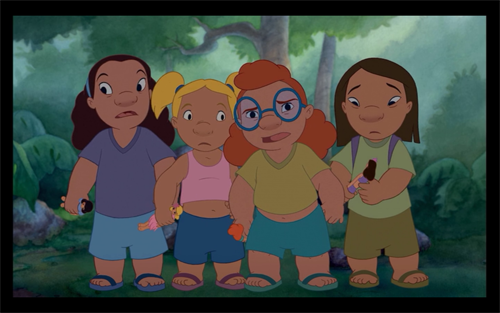
Image credit: captured from Netflix.com
Lilo, however, is bored with simple stories. Her doll is an adorable, muppet-like monster named Scrump whose life is soon to come to a gory end. “Her head’s too big,” Lilo says, “so I pretend a bug laid eggs in her ears, and she’s upset because she only has a few days to—.” Delivered in her cheerful, indomitable voice, the line doesn’t feel particularly morbid but rather testifies to Lilo’s vibrant inner life, filled with life-and-death struggles whose fantastic SF elements insulate them from the concerns of her fragile daily existence. Her friends, on the other hand, are bored, if not grossed out, by Lilo's ability to love a doll that isn't manufactured to demonstrate an artificial perfection. They leave the scene before she can even finish the sentence.
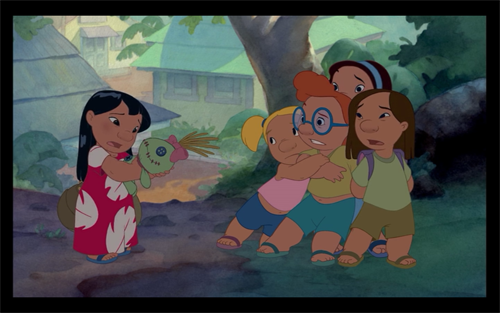
Poor Scrump. Everyone's afraid of him! Image credit: captured from Netflix.com
If that early scene wasn't enough to emphasize Lilo's distaste for conventional narratives, another comic scene (recorded, but sadly never animated) drives home the point. Hearing one too many rich, grotesque, continental-American tourist repeat the same boring question ("where is the beach?") Lilo launches her own poetic revenge. Using her local connections, she makes sure that a siren is going to be tested, then convinces the tourists that the test actually heralds a tsunami that moves "faster than the speed of sound." Lacking any sense of curiosity or independent thought, the Lemming-like tourists flee in a panicked herd. The local CPS officer doesn't share their morbid glee, but Lilo lets him in on a secret. "If you lived here," she says, "you'd understand." Lilo's love for the morbid and bizarre has, it turns out, some specific roots: a bitter frustration of dealing with insensitive outsiders who refuse to recognize the humanity of the natives.
Older sister Nani seems too busy for stories; she’s constantly scrambling to get a job and prove to the local Child Protective Services officer that she can function as a decent mother. Even so, she shares with Lilo an ability to inhabit a world of dark fantasy and a distaste for conventional narratives. When she’s fired from her waitress job, her first reaction is to call it a “stupid fakey Luau.” Her second is to tell Lilo that “The master’s a vampire, and he wants me to join his leigon of the undead.”
The obsession that Lilo and Nani have for rough-hewn narratives also applies to rough-hewn people. Lilo and Stitch probably features more diversity than any Disney movie not starring animals, and Lilo, at least, loves it. She collects photos of people—all obese, all living rich and fulfilling lives. Looking up at these people whose body types prohibit their participation in any other Disney movie, she draws only one conclusion. “They’re beautiful,” she says. Such courageous vision is probably the reason she can tell her own horrific story without flinching; looking at a photo taken before her parents died, she speaks simply and plainly. “That’s us, before. It was rainy, and they went for a drive.” Then she turns her attention back to Stitch. “What happened to yours? I hear you cry at night. Do you dream about them? I know that’s why you wreck things, and push me.”
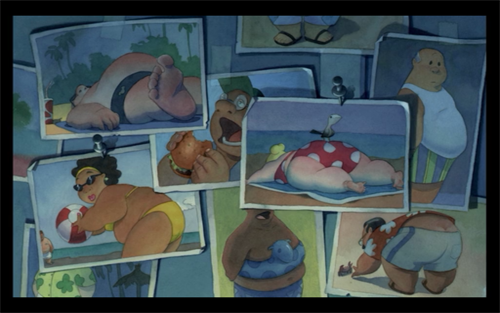
"They're Beautiful!" Image credit: captured from Netflix.com
I have a harder time loving the movie as a whole than I do its characters, themes, and often shockingly-precise dialog. Stitch brings with him a lot of space-opera insanity that would be joyous in another movie, but here seems an unwelcome violation of the film’s otherwise gentle and thoughtful tone. I’m not sure how the audience is supposed to feel, for instance, when Snitch takes a chainsaw to Lilo and Nani’s house. It’s wacky fun at the time, but then we have to face a distraught Nani, who races home in anguish just as she’d finally found a decent job, and has to watch in despair as her sister is carted off by the sorrowful CPS officer.
Despite its rough edges, Lilo and Stitch pulled in nearly $150 million at the domestic box office, not quite the blockbuster numbers of Frozen, but a decent profit for a film with a budget of only $80 million. Sadly, while the success of Lilo and Stitch may speak well of the average American moviegoer, only Pixar has come close to producing the same sort of thoughtful, emotionally-complex storytelling, and they have had much more success with boys than girls as protagonists. Lilo and Stitch remains, then, as a unique, flawed masterpiece—and above all a warning about the stories we tell, the images we show, and the damage done when people are sold a pristine image of life whose glamor they will never be able to equal.






Recent comments
2 years 29 weeks ago
2 years 44 weeks ago
2 years 44 weeks ago
2 years 50 weeks ago
3 years 4 weeks ago
3 years 4 weeks ago
3 years 4 weeks ago
3 years 6 weeks ago
3 years 6 weeks ago
3 years 6 weeks ago